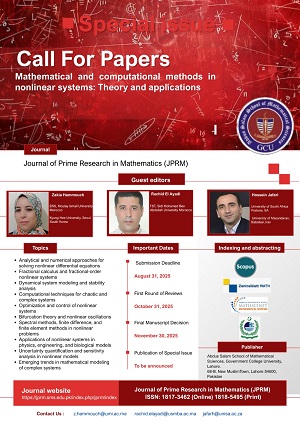Numerical Computations of Fractional Differential Equations in Engineering using the Polynomial Least Squares Method
Keywords:
Caputo Fractional Derivative; Fractional Calculus; Numerical Analysis; Fractional Differential Equations; Polynomial Least Squares Method.Abstract
Fractional differential equations appear in the modeling of science and engineering phenomena including classical mechanics, quantum mechanics, thermodynamics, fluid mechanics, relativity theory and chemical engineering. In this paper, the least squares method is used to find the numerical solution of fractional differential equations appearing in mechanics and engineering. The increasing interest in applications of fractional calculus has motivated the development and study of numerical methods specifically created to solve fractional differential equations. A unique feature is that engineers, physicists and scientists come across processes which lead to involve fractional differential equations. When dealing with more complicated systems with no precise solutions other than approximations, numerical methods are relied on to obtain solutions. The suggested method is used to solve various linear and non-linear problems of constant-order. The proposed scheme is found to be computationally effective with fast convergence.
Downloads
References
[1] M. D. Ortigueira and J. T. Machado, What is a fractional derivative?, J. Comput. Phys. 293 (2015), 4–13. 1
[2] R. Almeida, A Caputo fractional derivative of a function with respect to another function, Commun. Nonlinear Sci. Numer. Simul. 44 (2017), 460–481. 1
[3] A. A. Kilbas, H. M. Srivastava and J. J. Trujillo, Theory and applications of fractional differential equations, Vol. 204, Elsevier, 2006. 1
[4] I. Podlubny, Fractional differential equations: an introduction to fractional derivatives, fractional differential equations, to methods of their solution and some of their applications, Elsevier, 1998. 1
[5] T. Kisela, Fractional differential equations and their applications, Faculty of Mechanical Engineering, Institute of Mathematics, 2008. 1
[6] M. L. Johnson and L. M. Faunt, Parameter estimation by least-squares methods, in Methods in Enzymology, Vol. 210, Academic Press, 1992, 1–37. 1
[7] R. Almeida, N. R. Bastos and M. T. T. Monteiro, Modeling some real phenomena by fractional differential equations, Math. Methods Appl. Sci. 39(16) (2016), 4846–4855. 1
[8] S. Abbas, Existence of solutions to fractional order ordinary and delay differential equations and applications, Electron. J. Differ. Equ. (EJDE), 2011, Paper No. 1
[9] H. Abdi, The method of least squares, Encycl. Meas. Statist. 1 (2007), 530–532. 1
[10] T. Oyedepo, O. A. Taiwo, J. U. Abubakar and Z. O. Ogunwobi, Numerical studies for solving fractional integrodifferential equations by using least squares method and Bernstein polynomials, Fluid Mech.: Open Access 3(3)
(2016), 1000142. 1
[11] A. H. Bhatti and S. B. Karim, Solving ordinary differential equations (ODEs) using least square method based on Wang Ball curves, Math. Statist. 10(1) (2022), 74–87. 1
[12] K. Diethelm, The Analysis of Fractional Differential Equations: An Application-Oriented Exposition Using Differential Operators of Caputo Type, Springer, Berlin, 2021. 2.1, 2.3
[13] C. Bota and B. C˘aruntu, Analytical approximate solutions for quadratic Riccati differential equation of fractional order using the polynomial least squares method, Chaos Solitons Fractals 102 (2017), 339–345. 4
[14] D. Nuryani, E. Rusyaman and B. Subartini, Convergence analysis from the solution of Riccati’s fractional differential equation by using polynomial least squares method, Eksakta: Berkala Ilmiah Bidang MIPA 21(1) (2020), 7–14. 4
[15] B. S. H. Kashkari and M. I. Syam, Fractional-order Legendre operational matrix of fractional integration for solving the Riccati equation with fractional order, Appl. Math. Comput. 290 (2016), 281–291. 4
[16] C. Milici, G. Dr˘ag˘anescu and J. T. Machado, Introduction to fractional differential equations, Vol. 25, Springer, 2018. 4
[17] H. Jafari, S. Das and H. Tajadodi, Solving a multi-order fractional differential equation using homotopy analysis method, J. King Saud Univ. Sci. 23(2) (2011), 151–155. 4
[18] E. H. Doha, A. H. Bhrawy and S. S. Ezz-Eldien, Efficient Chebyshev spectral methods for solving multi-term fractional orders differential equations, Appl. Math. Model. 35 (2011), 5662–5672. 4, 4
[19] S. H. Hosseinnia, A. Ranjbar and S. Momani, Using an enhanced homotopy perturbation method in fractional differential equations via deforming the linear part, Comput. Math. Appl. 56 (2008), 3138–3149. 4
[20] Y. Li, N. Sun, B. Zheng, Q. Wang and Y. Zhang, Wavelet operational matrix method for solving the Riccati differential equation, Commun. Nonlinear Sci. Numer. Simul. 19 (2014), 483–493. 4
[21] W. M. Abd-Elhameed and Y. H. Youssri, New spectral solutions of multi-term fractional order initial value problems with error analysis, Comput. Model. Eng. Sci. 105 (2015), 375–398. 4
[22] M. Tanveer, S. Ullah and N. A. Shah, Thermal analysis of free convection flows of viscous carbon nanotubes nanofluids with generalized thermal transport: a Prabhakar fractional model, J. Therm. Anal. Calorim. 144
(2021), 2327–2336. 1
[23] S. Ullah, S. Zulfiqar, A. A. Buhader and N. A. Khan, Analysis of Caputo-Fabrizio fractional order semi-linear parabolic equations via effective amalgamated technique, Phys. Scr. 96(3) (2021), 035214. 1
[24] E. C¸ elik and D. U¸car, Analysis of the logistic growth model with Taylor matrix and collocation method, Int. J. Anal. Appl. 21 (2023), 58. 1
[25] D. U¸car, Inequalities for different type of functions via Caputo fractional derivative, AIMS Math. 7(7) (2022), 12815–12826. 1
[26] D. U¸car, New conformable fractional operator and some related inequalities, Filomat 35(11) (2021), 3597–3606. 1
[27] D. U¸car and A. Akincali, Fractional integral inequalities on time scales, Open J. Math. Sci. 2 (2018), 361–370. 1
[28] I. Tlili, N. A. Shah, S. Ullah and H. Manzoor, New idea of Atangana–Baleanu time–fractional derivative to advection–diffusion equation, Math. Methods Appl. Sci. 44(3) (2021), 2521–2531. 1
[29] S. Ullah, A. I. K. Butt and A. Aish Buhader, Numerical investigation with stability analysis of time–fractional Korteweg–de Vries equations, Math. Methods Appl. Sci. 44(4) (2021), 3111–3126.
Downloads
Published
Issue
Section
License
Copyright (c) 2025 Shakeel Ahmed, Saif Ullah, Faiza tul Rasool

This work is licensed under a Creative Commons Attribution-NonCommercial-NoDerivatives 4.0 International License.






